Third Parties Influence in American Politics
VerifiedAdded on 2022/12/30
|13
|3739
|41
AI Summary
This article explores the role and impact of third parties in American politics. It discusses the dominance of the two-party system, the challenges faced by third parties, and their limited influence in elections. It also examines the logistical and financial obstacles that hinder the success of third parties in the US.
Contribute Materials
Your contribution can guide someone’s learning journey. Share your
documents today.
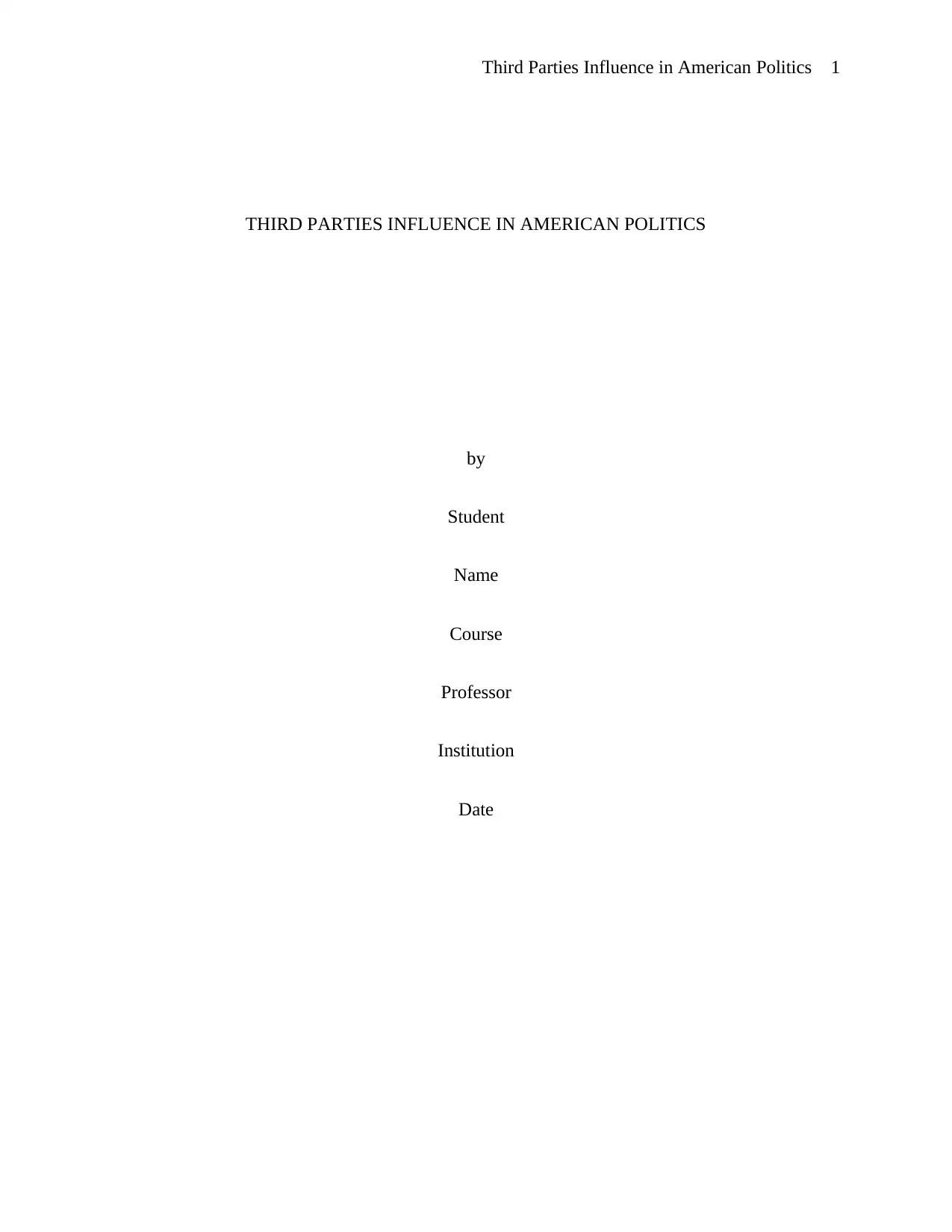
Third Parties Influence in American Politics 1
THIRD PARTIES INFLUENCE IN AMERICAN POLITICS
by
Student
Name
Course
Professor
Institution
Date
THIRD PARTIES INFLUENCE IN AMERICAN POLITICS
by
Student
Name
Course
Professor
Institution
Date
Secure Best Marks with AI Grader
Need help grading? Try our AI Grader for instant feedback on your assignments.
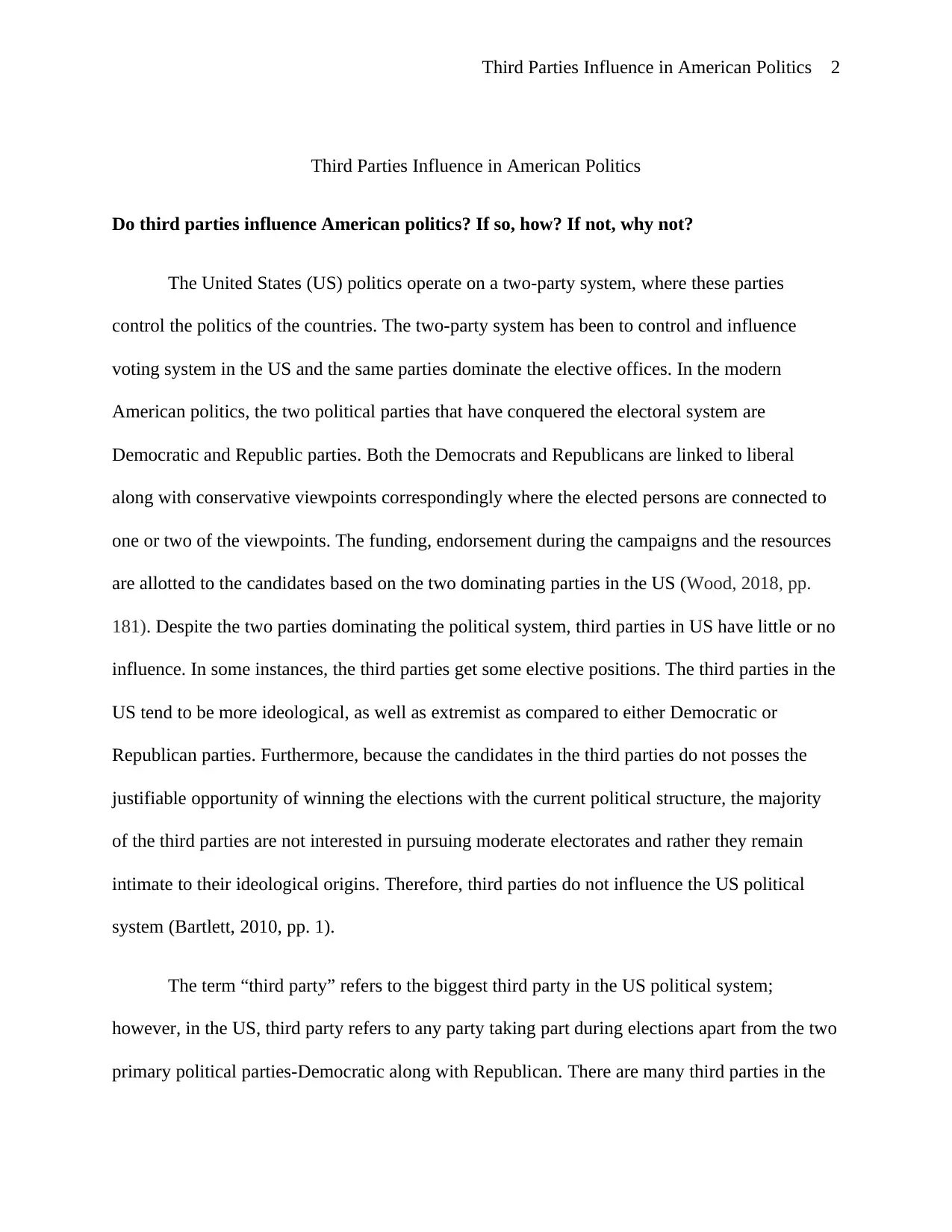
Third Parties Influence in American Politics 2
Third Parties Influence in American Politics
Do third parties influence American politics? If so, how? If not, why not?
The United States (US) politics operate on a two-party system, where these parties
control the politics of the countries. The two-party system has been to control and influence
voting system in the US and the same parties dominate the elective offices. In the modern
American politics, the two political parties that have conquered the electoral system are
Democratic and Republic parties. Both the Democrats and Republicans are linked to liberal
along with conservative viewpoints correspondingly where the elected persons are connected to
one or two of the viewpoints. The funding, endorsement during the campaigns and the resources
are allotted to the candidates based on the two dominating parties in the US (Wood, 2018, pp.
181). Despite the two parties dominating the political system, third parties in US have little or no
influence. In some instances, the third parties get some elective positions. The third parties in the
US tend to be more ideological, as well as extremist as compared to either Democratic or
Republican parties. Furthermore, because the candidates in the third parties do not posses the
justifiable opportunity of winning the elections with the current political structure, the majority
of the third parties are not interested in pursuing moderate electorates and rather they remain
intimate to their ideological origins. Therefore, third parties do not influence the US political
system (Bartlett, 2010, pp. 1).
The term “third party” refers to the biggest third party in the US political system;
however, in the US, third party refers to any party taking part during elections apart from the two
primary political parties-Democratic along with Republican. There are many third parties in the
Third Parties Influence in American Politics
Do third parties influence American politics? If so, how? If not, why not?
The United States (US) politics operate on a two-party system, where these parties
control the politics of the countries. The two-party system has been to control and influence
voting system in the US and the same parties dominate the elective offices. In the modern
American politics, the two political parties that have conquered the electoral system are
Democratic and Republic parties. Both the Democrats and Republicans are linked to liberal
along with conservative viewpoints correspondingly where the elected persons are connected to
one or two of the viewpoints. The funding, endorsement during the campaigns and the resources
are allotted to the candidates based on the two dominating parties in the US (Wood, 2018, pp.
181). Despite the two parties dominating the political system, third parties in US have little or no
influence. In some instances, the third parties get some elective positions. The third parties in the
US tend to be more ideological, as well as extremist as compared to either Democratic or
Republican parties. Furthermore, because the candidates in the third parties do not posses the
justifiable opportunity of winning the elections with the current political structure, the majority
of the third parties are not interested in pursuing moderate electorates and rather they remain
intimate to their ideological origins. Therefore, third parties do not influence the US political
system (Bartlett, 2010, pp. 1).
The term “third party” refers to the biggest third party in the US political system;
however, in the US, third party refers to any party taking part during elections apart from the two
primary political parties-Democratic along with Republican. There are many third parties in the
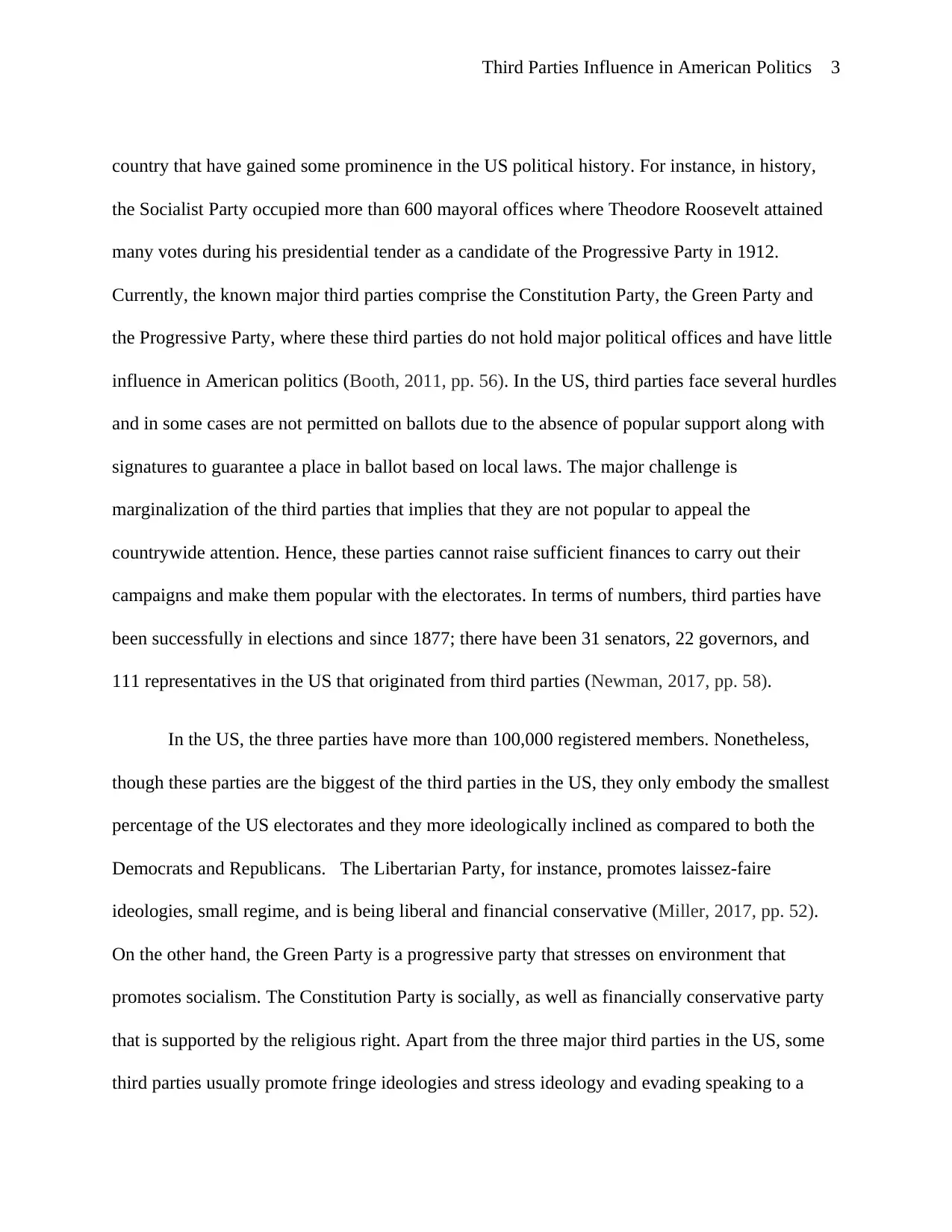
Third Parties Influence in American Politics 3
country that have gained some prominence in the US political history. For instance, in history,
the Socialist Party occupied more than 600 mayoral offices where Theodore Roosevelt attained
many votes during his presidential tender as a candidate of the Progressive Party in 1912.
Currently, the known major third parties comprise the Constitution Party, the Green Party and
the Progressive Party, where these third parties do not hold major political offices and have little
influence in American politics (Booth, 2011, pp. 56). In the US, third parties face several hurdles
and in some cases are not permitted on ballots due to the absence of popular support along with
signatures to guarantee a place in ballot based on local laws. The major challenge is
marginalization of the third parties that implies that they are not popular to appeal the
countrywide attention. Hence, these parties cannot raise sufficient finances to carry out their
campaigns and make them popular with the electorates. In terms of numbers, third parties have
been successfully in elections and since 1877; there have been 31 senators, 22 governors, and
111 representatives in the US that originated from third parties (Newman, 2017, pp. 58).
In the US, the three parties have more than 100,000 registered members. Nonetheless,
though these parties are the biggest of the third parties in the US, they only embody the smallest
percentage of the US electorates and they more ideologically inclined as compared to both the
Democrats and Republicans. The Libertarian Party, for instance, promotes laissez-faire
ideologies, small regime, and is being liberal and financial conservative (Miller, 2017, pp. 52).
On the other hand, the Green Party is a progressive party that stresses on environment that
promotes socialism. The Constitution Party is socially, as well as financially conservative party
that is supported by the religious right. Apart from the three major third parties in the US, some
third parties usually promote fringe ideologies and stress ideology and evading speaking to a
country that have gained some prominence in the US political history. For instance, in history,
the Socialist Party occupied more than 600 mayoral offices where Theodore Roosevelt attained
many votes during his presidential tender as a candidate of the Progressive Party in 1912.
Currently, the known major third parties comprise the Constitution Party, the Green Party and
the Progressive Party, where these third parties do not hold major political offices and have little
influence in American politics (Booth, 2011, pp. 56). In the US, third parties face several hurdles
and in some cases are not permitted on ballots due to the absence of popular support along with
signatures to guarantee a place in ballot based on local laws. The major challenge is
marginalization of the third parties that implies that they are not popular to appeal the
countrywide attention. Hence, these parties cannot raise sufficient finances to carry out their
campaigns and make them popular with the electorates. In terms of numbers, third parties have
been successfully in elections and since 1877; there have been 31 senators, 22 governors, and
111 representatives in the US that originated from third parties (Newman, 2017, pp. 58).
In the US, the three parties have more than 100,000 registered members. Nonetheless,
though these parties are the biggest of the third parties in the US, they only embody the smallest
percentage of the US electorates and they more ideologically inclined as compared to both the
Democrats and Republicans. The Libertarian Party, for instance, promotes laissez-faire
ideologies, small regime, and is being liberal and financial conservative (Miller, 2017, pp. 52).
On the other hand, the Green Party is a progressive party that stresses on environment that
promotes socialism. The Constitution Party is socially, as well as financially conservative party
that is supported by the religious right. Apart from the three major third parties in the US, some
third parties usually promote fringe ideologies and stress ideology and evading speaking to a

Third Parties Influence in American Politics 4
broad base. The American First Party (AFP) is a small-wing third party that is characterized as
pale conservative since they are socially, as well as financially conservative. The American First
Party promotes the ideology of forming a small government by abolishing federal programs like
the Department of Education and has the agenda of cutting taxes and permitting more vigorous
integration of state and church (Lindberg, 2010, pp. 142).
Nonetheless, the third parties has primary role in US politics, but there contribution has
not been that immense. They usually organize along with mobilize a single concern or position,
placing demands on political aspirants from the two major parties to deal with these issues. For
instance, segregationist American Independent Party presidential aspirant, George Wallace,
attained 13.5 per cent of the popular vote during the elections held in 1968. In reaction, the
Republican Party embraced a “Southern Strategy” to triumph the campaign of conventional
Democrats located in the South who were not in favour of the new Civil Rights movements
(Campbell, 2013, pp. 307). Though it is not possible that a third party will attain more votes and
popularity, they have a little influence during an election by taking away some votes from
candidates from major political parties. This trend was witnessed in 2000 election when the
Green Party candidate, Ralph Nader, denied some votes to Al Gore that resulted in the triumph
of George W. Bush as Republican candidate (Lee, 2012, pp. 269).Furthermore, statistics
demonstrate that around 83% of the US citizens consider that there is a major trouble with the
current two-part system in the US. The majority of these citizens claim that they more political
parties to make informed choices rather than those provided by the two leading parties in the US.
Regrettably, the US Constitution fundamentally makes the third parties unviable. Nonetheless,
broad base. The American First Party (AFP) is a small-wing third party that is characterized as
pale conservative since they are socially, as well as financially conservative. The American First
Party promotes the ideology of forming a small government by abolishing federal programs like
the Department of Education and has the agenda of cutting taxes and permitting more vigorous
integration of state and church (Lindberg, 2010, pp. 142).
Nonetheless, the third parties has primary role in US politics, but there contribution has
not been that immense. They usually organize along with mobilize a single concern or position,
placing demands on political aspirants from the two major parties to deal with these issues. For
instance, segregationist American Independent Party presidential aspirant, George Wallace,
attained 13.5 per cent of the popular vote during the elections held in 1968. In reaction, the
Republican Party embraced a “Southern Strategy” to triumph the campaign of conventional
Democrats located in the South who were not in favour of the new Civil Rights movements
(Campbell, 2013, pp. 307). Though it is not possible that a third party will attain more votes and
popularity, they have a little influence during an election by taking away some votes from
candidates from major political parties. This trend was witnessed in 2000 election when the
Green Party candidate, Ralph Nader, denied some votes to Al Gore that resulted in the triumph
of George W. Bush as Republican candidate (Lee, 2012, pp. 269).Furthermore, statistics
demonstrate that around 83% of the US citizens consider that there is a major trouble with the
current two-part system in the US. The majority of these citizens claim that they more political
parties to make informed choices rather than those provided by the two leading parties in the US.
Regrettably, the US Constitution fundamentally makes the third parties unviable. Nonetheless,
Secure Best Marks with AI Grader
Need help grading? Try our AI Grader for instant feedback on your assignments.
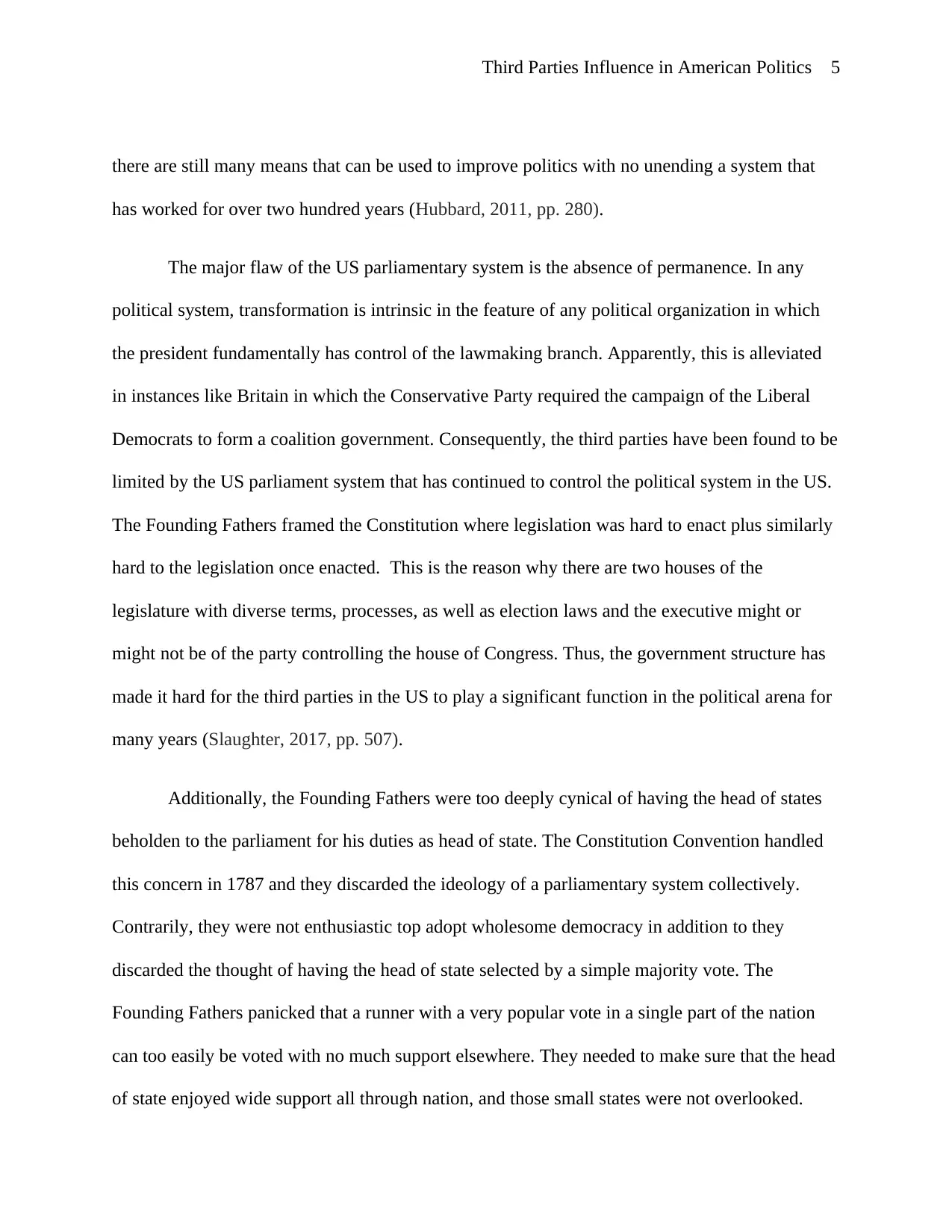
Third Parties Influence in American Politics 5
there are still many means that can be used to improve politics with no unending a system that
has worked for over two hundred years (Hubbard, 2011, pp. 280).
The major flaw of the US parliamentary system is the absence of permanence. In any
political system, transformation is intrinsic in the feature of any political organization in which
the president fundamentally has control of the lawmaking branch. Apparently, this is alleviated
in instances like Britain in which the Conservative Party required the campaign of the Liberal
Democrats to form a coalition government. Consequently, the third parties have been found to be
limited by the US parliament system that has continued to control the political system in the US.
The Founding Fathers framed the Constitution where legislation was hard to enact plus similarly
hard to the legislation once enacted. This is the reason why there are two houses of the
legislature with diverse terms, processes, as well as election laws and the executive might or
might not be of the party controlling the house of Congress. Thus, the government structure has
made it hard for the third parties in the US to play a significant function in the political arena for
many years (Slaughter, 2017, pp. 507).
Additionally, the Founding Fathers were too deeply cynical of having the head of states
beholden to the parliament for his duties as head of state. The Constitution Convention handled
this concern in 1787 and they discarded the ideology of a parliamentary system collectively.
Contrarily, they were not enthusiastic top adopt wholesome democracy in addition to they
discarded the thought of having the head of state selected by a simple majority vote. The
Founding Fathers panicked that a runner with a very popular vote in a single part of the nation
can too easily be voted with no much support elsewhere. They needed to make sure that the head
of state enjoyed wide support all through nation, and those small states were not overlooked.
there are still many means that can be used to improve politics with no unending a system that
has worked for over two hundred years (Hubbard, 2011, pp. 280).
The major flaw of the US parliamentary system is the absence of permanence. In any
political system, transformation is intrinsic in the feature of any political organization in which
the president fundamentally has control of the lawmaking branch. Apparently, this is alleviated
in instances like Britain in which the Conservative Party required the campaign of the Liberal
Democrats to form a coalition government. Consequently, the third parties have been found to be
limited by the US parliament system that has continued to control the political system in the US.
The Founding Fathers framed the Constitution where legislation was hard to enact plus similarly
hard to the legislation once enacted. This is the reason why there are two houses of the
legislature with diverse terms, processes, as well as election laws and the executive might or
might not be of the party controlling the house of Congress. Thus, the government structure has
made it hard for the third parties in the US to play a significant function in the political arena for
many years (Slaughter, 2017, pp. 507).
Additionally, the Founding Fathers were too deeply cynical of having the head of states
beholden to the parliament for his duties as head of state. The Constitution Convention handled
this concern in 1787 and they discarded the ideology of a parliamentary system collectively.
Contrarily, they were not enthusiastic top adopt wholesome democracy in addition to they
discarded the thought of having the head of state selected by a simple majority vote. The
Founding Fathers panicked that a runner with a very popular vote in a single part of the nation
can too easily be voted with no much support elsewhere. They needed to make sure that the head
of state enjoyed wide support all through nation, and those small states were not overlooked.
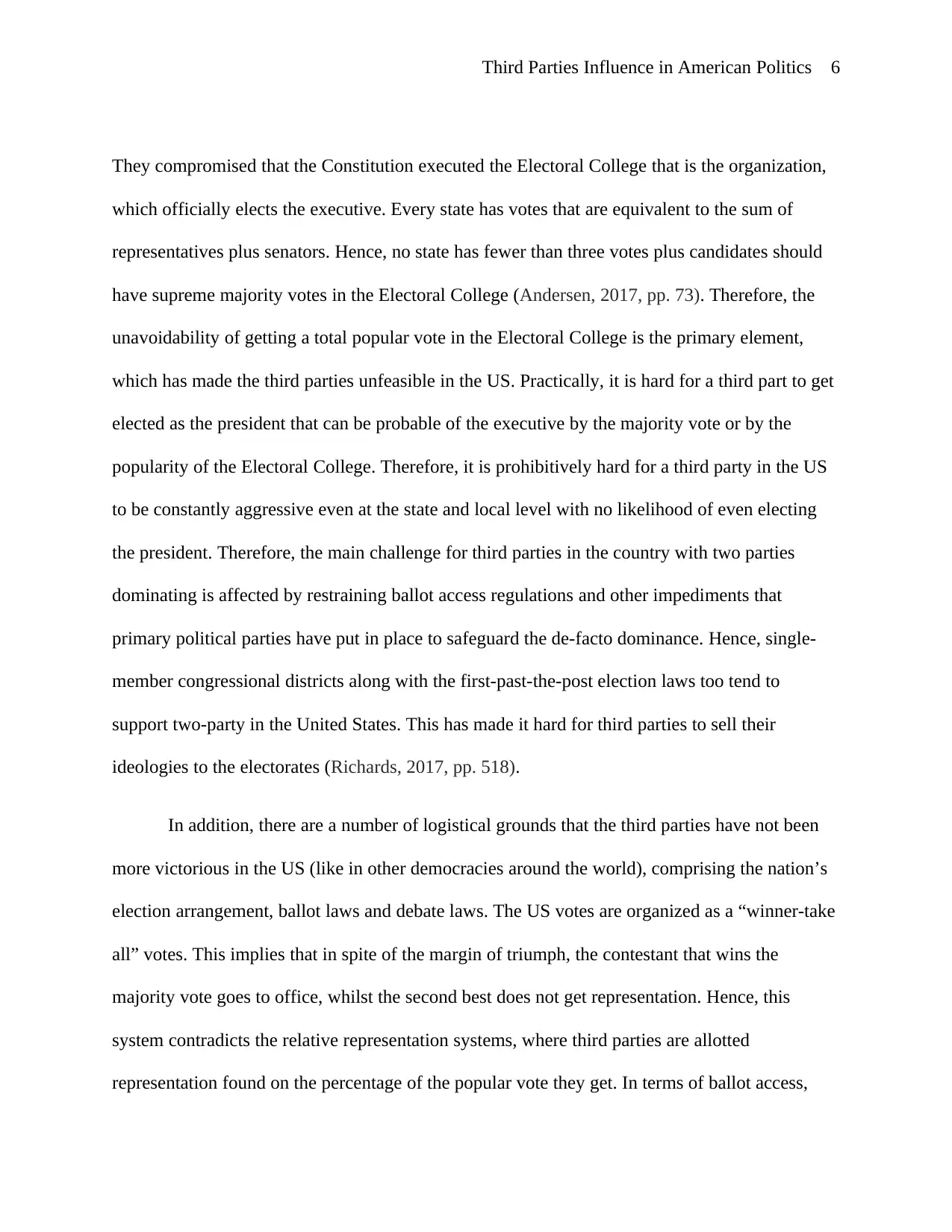
Third Parties Influence in American Politics 6
They compromised that the Constitution executed the Electoral College that is the organization,
which officially elects the executive. Every state has votes that are equivalent to the sum of
representatives plus senators. Hence, no state has fewer than three votes plus candidates should
have supreme majority votes in the Electoral College (Andersen, 2017, pp. 73). Therefore, the
unavoidability of getting a total popular vote in the Electoral College is the primary element,
which has made the third parties unfeasible in the US. Practically, it is hard for a third part to get
elected as the president that can be probable of the executive by the majority vote or by the
popularity of the Electoral College. Therefore, it is prohibitively hard for a third party in the US
to be constantly aggressive even at the state and local level with no likelihood of even electing
the president. Therefore, the main challenge for third parties in the country with two parties
dominating is affected by restraining ballot access regulations and other impediments that
primary political parties have put in place to safeguard the de-facto dominance. Hence, single-
member congressional districts along with the first-past-the-post election laws too tend to
support two-party in the United States. This has made it hard for third parties to sell their
ideologies to the electorates (Richards, 2017, pp. 518).
In addition, there are a number of logistical grounds that the third parties have not been
more victorious in the US (like in other democracies around the world), comprising the nation’s
election arrangement, ballot laws and debate laws. The US votes are organized as a “winner-take
all” votes. This implies that in spite of the margin of triumph, the contestant that wins the
majority vote goes to office, whilst the second best does not get representation. Hence, this
system contradicts the relative representation systems, where third parties are allotted
representation found on the percentage of the popular vote they get. In terms of ballot access,
They compromised that the Constitution executed the Electoral College that is the organization,
which officially elects the executive. Every state has votes that are equivalent to the sum of
representatives plus senators. Hence, no state has fewer than three votes plus candidates should
have supreme majority votes in the Electoral College (Andersen, 2017, pp. 73). Therefore, the
unavoidability of getting a total popular vote in the Electoral College is the primary element,
which has made the third parties unfeasible in the US. Practically, it is hard for a third part to get
elected as the president that can be probable of the executive by the majority vote or by the
popularity of the Electoral College. Therefore, it is prohibitively hard for a third party in the US
to be constantly aggressive even at the state and local level with no likelihood of even electing
the president. Therefore, the main challenge for third parties in the country with two parties
dominating is affected by restraining ballot access regulations and other impediments that
primary political parties have put in place to safeguard the de-facto dominance. Hence, single-
member congressional districts along with the first-past-the-post election laws too tend to
support two-party in the United States. This has made it hard for third parties to sell their
ideologies to the electorates (Richards, 2017, pp. 518).
In addition, there are a number of logistical grounds that the third parties have not been
more victorious in the US (like in other democracies around the world), comprising the nation’s
election arrangement, ballot laws and debate laws. The US votes are organized as a “winner-take
all” votes. This implies that in spite of the margin of triumph, the contestant that wins the
majority vote goes to office, whilst the second best does not get representation. Hence, this
system contradicts the relative representation systems, where third parties are allotted
representation found on the percentage of the popular vote they get. In terms of ballot access,
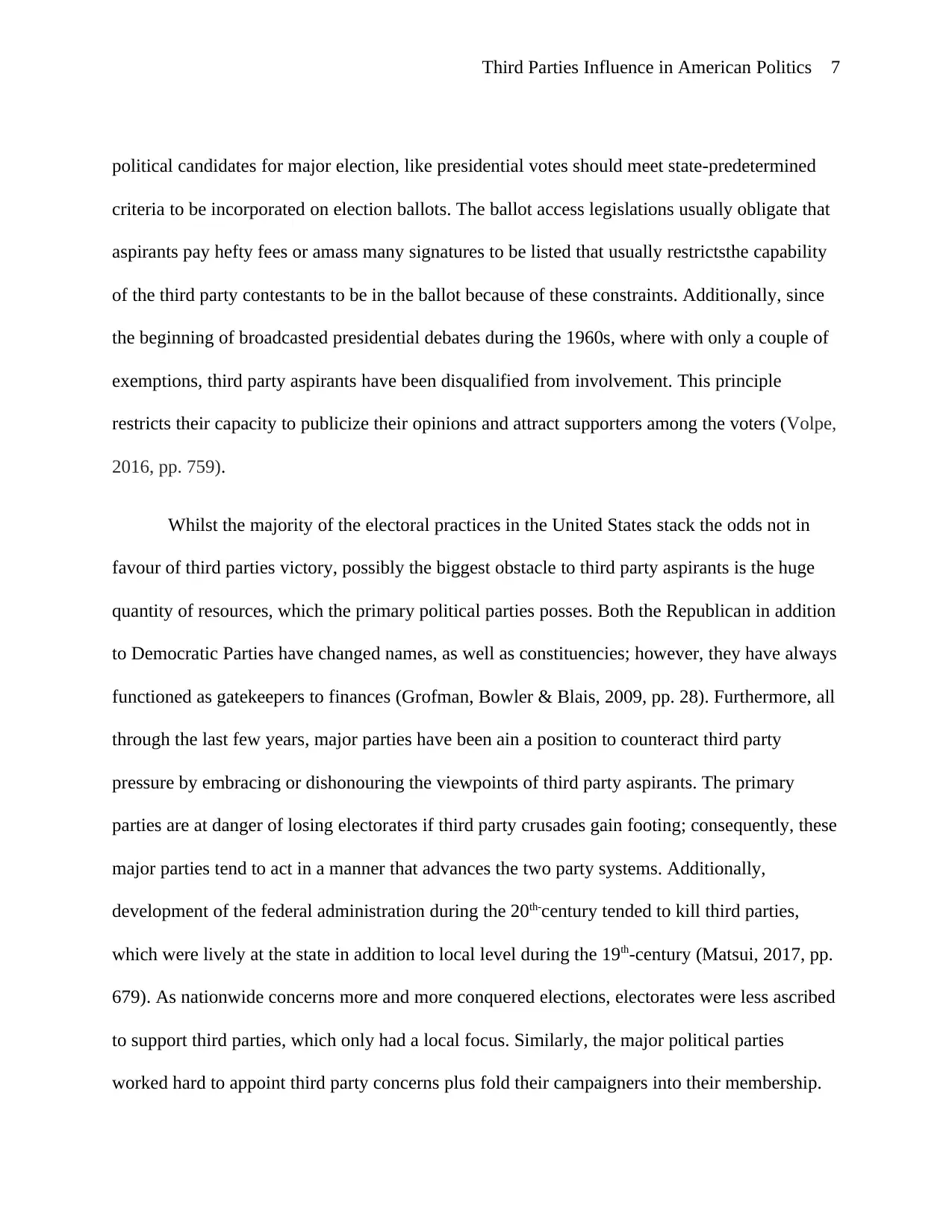
Third Parties Influence in American Politics 7
political candidates for major election, like presidential votes should meet state-predetermined
criteria to be incorporated on election ballots. The ballot access legislations usually obligate that
aspirants pay hefty fees or amass many signatures to be listed that usually restrictsthe capability
of the third party contestants to be in the ballot because of these constraints. Additionally, since
the beginning of broadcasted presidential debates during the 1960s, where with only a couple of
exemptions, third party aspirants have been disqualified from involvement. This principle
restricts their capacity to publicize their opinions and attract supporters among the voters (Volpe,
2016, pp. 759).
Whilst the majority of the electoral practices in the United States stack the odds not in
favour of third parties victory, possibly the biggest obstacle to third party aspirants is the huge
quantity of resources, which the primary political parties posses. Both the Republican in addition
to Democratic Parties have changed names, as well as constituencies; however, they have always
functioned as gatekeepers to finances (Grofman, Bowler & Blais, 2009, pp. 28). Furthermore, all
through the last few years, major parties have been ain a position to counteract third party
pressure by embracing or dishonouring the viewpoints of third party aspirants. The primary
parties are at danger of losing electorates if third party crusades gain footing; consequently, these
major parties tend to act in a manner that advances the two party systems. Additionally,
development of the federal administration during the 20th-century tended to kill third parties,
which were lively at the state in addition to local level during the 19th-century (Matsui, 2017, pp.
679). As nationwide concerns more and more conquered elections, electorates were less ascribed
to support third parties, which only had a local focus. Similarly, the major political parties
worked hard to appoint third party concerns plus fold their campaigners into their membership.
political candidates for major election, like presidential votes should meet state-predetermined
criteria to be incorporated on election ballots. The ballot access legislations usually obligate that
aspirants pay hefty fees or amass many signatures to be listed that usually restrictsthe capability
of the third party contestants to be in the ballot because of these constraints. Additionally, since
the beginning of broadcasted presidential debates during the 1960s, where with only a couple of
exemptions, third party aspirants have been disqualified from involvement. This principle
restricts their capacity to publicize their opinions and attract supporters among the voters (Volpe,
2016, pp. 759).
Whilst the majority of the electoral practices in the United States stack the odds not in
favour of third parties victory, possibly the biggest obstacle to third party aspirants is the huge
quantity of resources, which the primary political parties posses. Both the Republican in addition
to Democratic Parties have changed names, as well as constituencies; however, they have always
functioned as gatekeepers to finances (Grofman, Bowler & Blais, 2009, pp. 28). Furthermore, all
through the last few years, major parties have been ain a position to counteract third party
pressure by embracing or dishonouring the viewpoints of third party aspirants. The primary
parties are at danger of losing electorates if third party crusades gain footing; consequently, these
major parties tend to act in a manner that advances the two party systems. Additionally,
development of the federal administration during the 20th-century tended to kill third parties,
which were lively at the state in addition to local level during the 19th-century (Matsui, 2017, pp.
679). As nationwide concerns more and more conquered elections, electorates were less ascribed
to support third parties, which only had a local focus. Similarly, the major political parties
worked hard to appoint third party concerns plus fold their campaigners into their membership.
Paraphrase This Document
Need a fresh take? Get an instant paraphrase of this document with our AI Paraphraser
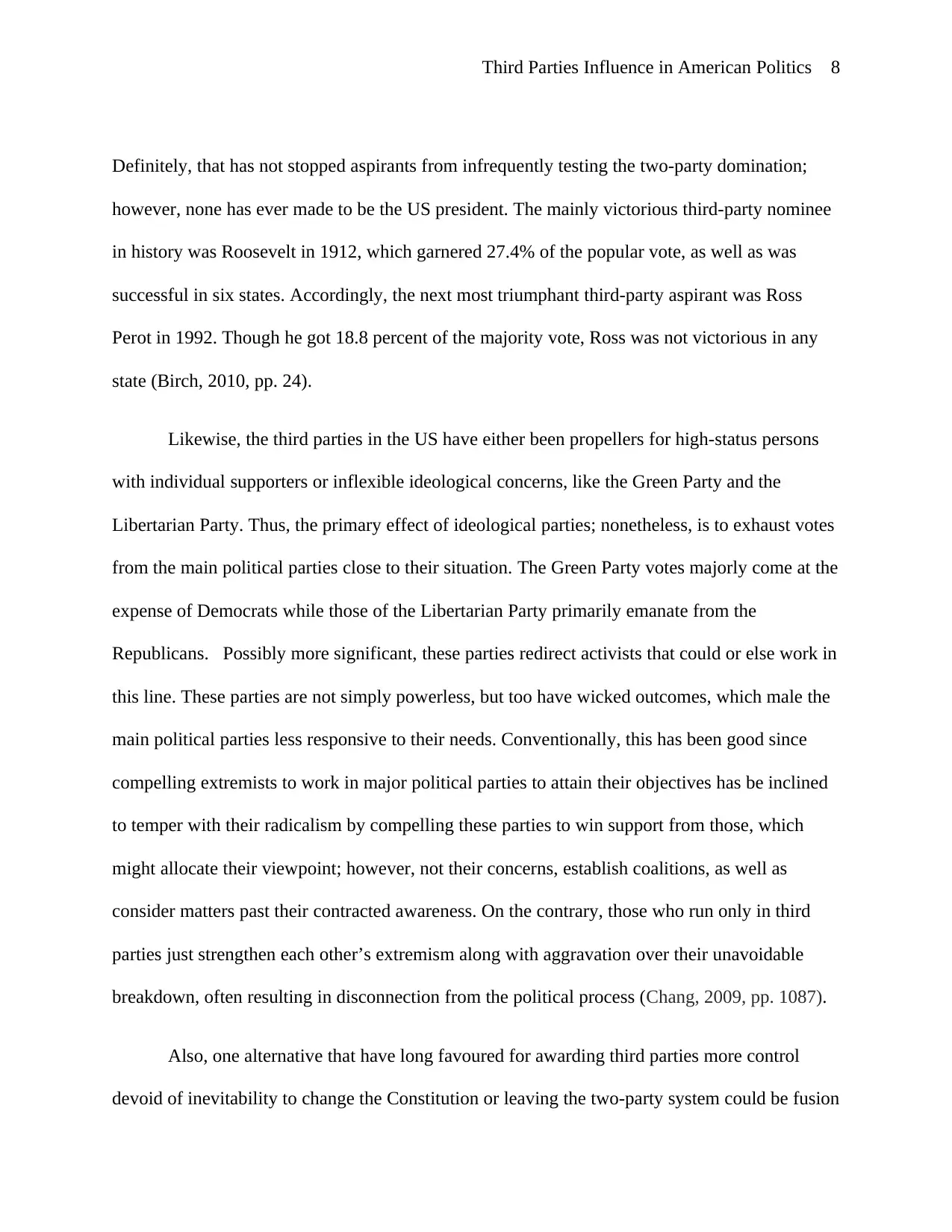
Third Parties Influence in American Politics 8
Definitely, that has not stopped aspirants from infrequently testing the two-party domination;
however, none has ever made to be the US president. The mainly victorious third-party nominee
in history was Roosevelt in 1912, which garnered 27.4% of the popular vote, as well as was
successful in six states. Accordingly, the next most triumphant third-party aspirant was Ross
Perot in 1992. Though he got 18.8 percent of the majority vote, Ross was not victorious in any
state (Birch, 2010, pp. 24).
Likewise, the third parties in the US have either been propellers for high-status persons
with individual supporters or inflexible ideological concerns, like the Green Party and the
Libertarian Party. Thus, the primary effect of ideological parties; nonetheless, is to exhaust votes
from the main political parties close to their situation. The Green Party votes majorly come at the
expense of Democrats while those of the Libertarian Party primarily emanate from the
Republicans. Possibly more significant, these parties redirect activists that could or else work in
this line. These parties are not simply powerless, but too have wicked outcomes, which male the
main political parties less responsive to their needs. Conventionally, this has been good since
compelling extremists to work in major political parties to attain their objectives has be inclined
to temper with their radicalism by compelling these parties to win support from those, which
might allocate their viewpoint; however, not their concerns, establish coalitions, as well as
consider matters past their contracted awareness. On the contrary, those who run only in third
parties just strengthen each other’s extremism along with aggravation over their unavoidable
breakdown, often resulting in disconnection from the political process (Chang, 2009, pp. 1087).
Also, one alternative that have long favoured for awarding third parties more control
devoid of inevitability to change the Constitution or leaving the two-party system could be fusion
Definitely, that has not stopped aspirants from infrequently testing the two-party domination;
however, none has ever made to be the US president. The mainly victorious third-party nominee
in history was Roosevelt in 1912, which garnered 27.4% of the popular vote, as well as was
successful in six states. Accordingly, the next most triumphant third-party aspirant was Ross
Perot in 1992. Though he got 18.8 percent of the majority vote, Ross was not victorious in any
state (Birch, 2010, pp. 24).
Likewise, the third parties in the US have either been propellers for high-status persons
with individual supporters or inflexible ideological concerns, like the Green Party and the
Libertarian Party. Thus, the primary effect of ideological parties; nonetheless, is to exhaust votes
from the main political parties close to their situation. The Green Party votes majorly come at the
expense of Democrats while those of the Libertarian Party primarily emanate from the
Republicans. Possibly more significant, these parties redirect activists that could or else work in
this line. These parties are not simply powerless, but too have wicked outcomes, which male the
main political parties less responsive to their needs. Conventionally, this has been good since
compelling extremists to work in major political parties to attain their objectives has be inclined
to temper with their radicalism by compelling these parties to win support from those, which
might allocate their viewpoint; however, not their concerns, establish coalitions, as well as
consider matters past their contracted awareness. On the contrary, those who run only in third
parties just strengthen each other’s extremism along with aggravation over their unavoidable
breakdown, often resulting in disconnection from the political process (Chang, 2009, pp. 1087).
Also, one alternative that have long favoured for awarding third parties more control
devoid of inevitability to change the Constitution or leaving the two-party system could be fusion

Third Parties Influence in American Politics 9
voting. Based on the fusion voting, the third parties in the US would cross-endorse main party
nominees plus have their votes combined. The fusion organization has long been functional in
New York that has third parties that comprise the Green Party and Conservative Party among
others. Also, Oregon has lately embraced the fusion voting to accommodate the third parties. The
primary advantage of the fusion voting could compel the main party aspirants to look for extra
appointment of third parties plus work to harbor their concerns. For instance, in New York the
letdown of a Republican aspirant to as well safeguard the Conservative Party selection
practically assures crush (Blake, 2016, pp. 1). In addition, the fusion voting too permits for
appealing alliances plus offers important information to the electorates. Thus, a Republican with
cross support from the Liberal Party can be feasible in a profoundly Democratic region. In many
instances, this leaves third party aspirants to finance their political campaigns. Also, with less
media coverage, the third party aspirants are left to look for other ways of exposure to boost
finances and other resources to run a winning campaign (Schraufnagel, 2013, pp. 367).
In conclusion, US electorates have not voted a third party aspirant since the time of
Abraham Lincoln when the marginal Republican Party during this time defeated the Whigs in
addition to the Democrats during the 1860s on the anti-slavery stage. It is the scenery of US
society plus the beliefs of US citizens that we have comparatively few on the excessive. Many
US citizens are comparatively modest and they may run contentedly in a system in which one
party is somewhat to the right while the other somewhat to the left. These citizens do no see any
huge need for an option. Electorates frequently agonize that an election for a third party applicant
is a “waste” since they cannot win. Thus, the third parties frequently organize about a solitary
character or a single concern and which result in less attractiveness among electorates. Possibly
voting. Based on the fusion voting, the third parties in the US would cross-endorse main party
nominees plus have their votes combined. The fusion organization has long been functional in
New York that has third parties that comprise the Green Party and Conservative Party among
others. Also, Oregon has lately embraced the fusion voting to accommodate the third parties. The
primary advantage of the fusion voting could compel the main party aspirants to look for extra
appointment of third parties plus work to harbor their concerns. For instance, in New York the
letdown of a Republican aspirant to as well safeguard the Conservative Party selection
practically assures crush (Blake, 2016, pp. 1). In addition, the fusion voting too permits for
appealing alliances plus offers important information to the electorates. Thus, a Republican with
cross support from the Liberal Party can be feasible in a profoundly Democratic region. In many
instances, this leaves third party aspirants to finance their political campaigns. Also, with less
media coverage, the third party aspirants are left to look for other ways of exposure to boost
finances and other resources to run a winning campaign (Schraufnagel, 2013, pp. 367).
In conclusion, US electorates have not voted a third party aspirant since the time of
Abraham Lincoln when the marginal Republican Party during this time defeated the Whigs in
addition to the Democrats during the 1860s on the anti-slavery stage. It is the scenery of US
society plus the beliefs of US citizens that we have comparatively few on the excessive. Many
US citizens are comparatively modest and they may run contentedly in a system in which one
party is somewhat to the right while the other somewhat to the left. These citizens do no see any
huge need for an option. Electorates frequently agonize that an election for a third party applicant
is a “waste” since they cannot win. Thus, the third parties frequently organize about a solitary
character or a single concern and which result in less attractiveness among electorates. Possibly
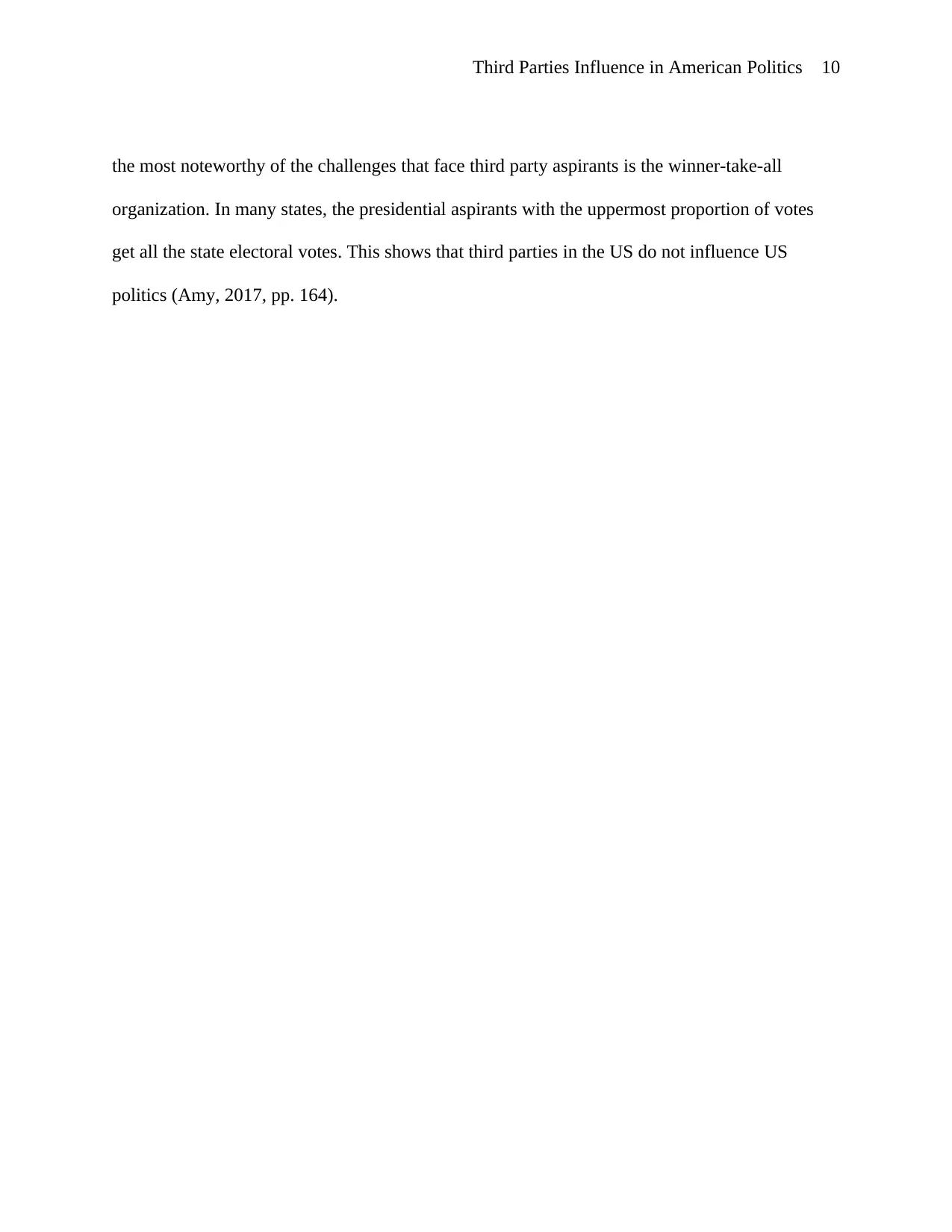
Third Parties Influence in American Politics 10
the most noteworthy of the challenges that face third party aspirants is the winner-take-all
organization. In many states, the presidential aspirants with the uppermost proportion of votes
get all the state electoral votes. This shows that third parties in the US do not influence US
politics (Amy, 2017, pp. 164).
the most noteworthy of the challenges that face third party aspirants is the winner-take-all
organization. In many states, the presidential aspirants with the uppermost proportion of votes
get all the state electoral votes. This shows that third parties in the US do not influence US
politics (Amy, 2017, pp. 164).
Secure Best Marks with AI Grader
Need help grading? Try our AI Grader for instant feedback on your assignments.

Third Parties Influence in American Politics 11
References
Amy, D. J. (2013). “Challengers to Duopoly: Why Third Parties Matter in American Two?Party
Politics”. Political Science Quarterly (Wiley-Blackwell), 128(1), 164–165.
Andersen, L. M. F. (2017). “Liberty Power: Antislavery Third Parties and the Transformation of
American Politics”. Civil War History, 63(1), 72–73.
Bartlett, B. (2010). “Why Third Parties Can't Compete”. Forbes. Retrieved May 16, 2019 from
https://www.forbes.com/2010/05/13/third-parties-fusion-voting-elections-opinions-columnists-
bruce-bartlett.html#5dc0f7655f7a.
Birch, S. (2010) “Patterns of Electoral Malpractice”. Working Paper No. 4. Project on
Malpractice in New and Semi‐Democracies. University of Essex.
Blake, A. (2016). “Why are there only two parties in American politics?” The Washington Post.
`Retrieved May 16, 2019 from https://www.washingtonpost.com/news/the
fix/wp/2016/04/27/why-are-there-only-two-parties-in-american politics/?
noredirect=on&utm_term=.b048d7a74648.
Booth, D. (2011) “Governance for development in Africa: building on what works”. Policy Brief
01. Africa Power and Politics Programme. London: ODI.
Chang, E. (2009) "Electoral Incentives and Budgetary Spending: Rethinking the Role of
Political Institutions." Journal of Politics 70 (4): 1086‐97.
References
Amy, D. J. (2013). “Challengers to Duopoly: Why Third Parties Matter in American Two?Party
Politics”. Political Science Quarterly (Wiley-Blackwell), 128(1), 164–165.
Andersen, L. M. F. (2017). “Liberty Power: Antislavery Third Parties and the Transformation of
American Politics”. Civil War History, 63(1), 72–73.
Bartlett, B. (2010). “Why Third Parties Can't Compete”. Forbes. Retrieved May 16, 2019 from
https://www.forbes.com/2010/05/13/third-parties-fusion-voting-elections-opinions-columnists-
bruce-bartlett.html#5dc0f7655f7a.
Birch, S. (2010) “Patterns of Electoral Malpractice”. Working Paper No. 4. Project on
Malpractice in New and Semi‐Democracies. University of Essex.
Blake, A. (2016). “Why are there only two parties in American politics?” The Washington Post.
`Retrieved May 16, 2019 from https://www.washingtonpost.com/news/the
fix/wp/2016/04/27/why-are-there-only-two-parties-in-american politics/?
noredirect=on&utm_term=.b048d7a74648.
Booth, D. (2011) “Governance for development in Africa: building on what works”. Policy Brief
01. Africa Power and Politics Programme. London: ODI.
Chang, E. (2009) "Electoral Incentives and Budgetary Spending: Rethinking the Role of
Political Institutions." Journal of Politics 70 (4): 1086‐97.
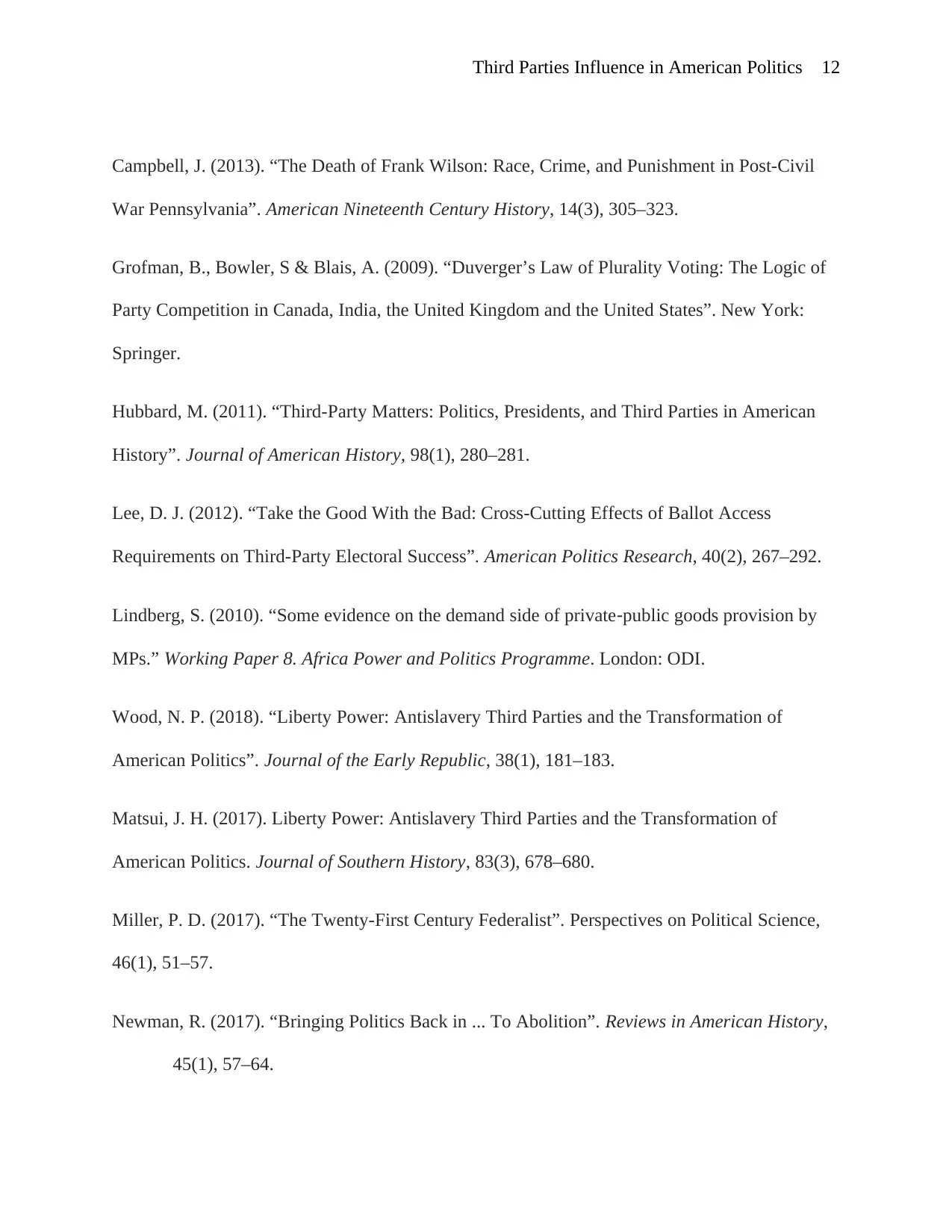
Third Parties Influence in American Politics 12
Campbell, J. (2013). “The Death of Frank Wilson: Race, Crime, and Punishment in Post-Civil
War Pennsylvania”. American Nineteenth Century History, 14(3), 305–323.
Grofman, B., Bowler, S & Blais, A. (2009). “Duverger’s Law of Plurality Voting: The Logic of
Party Competition in Canada, India, the United Kingdom and the United States”. New York:
Springer.
Hubbard, M. (2011). “Third-Party Matters: Politics, Presidents, and Third Parties in American
History”. Journal of American History, 98(1), 280–281.
Lee, D. J. (2012). “Take the Good With the Bad: Cross-Cutting Effects of Ballot Access
Requirements on Third-Party Electoral Success”. American Politics Research, 40(2), 267–292.
Lindberg, S. (2010). “Some evidence on the demand side of private‐public goods provision by
MPs.” Working Paper 8. Africa Power and Politics Programme. London: ODI.
Wood, N. P. (2018). “Liberty Power: Antislavery Third Parties and the Transformation of
American Politics”. Journal of the Early Republic, 38(1), 181–183.
Matsui, J. H. (2017). Liberty Power: Antislavery Third Parties and the Transformation of
American Politics. Journal of Southern History, 83(3), 678–680.
Miller, P. D. (2017). “The Twenty-First Century Federalist”. Perspectives on Political Science,
46(1), 51–57.
Newman, R. (2017). “Bringing Politics Back in ... To Abolition”. Reviews in American History,
45(1), 57–64.
Campbell, J. (2013). “The Death of Frank Wilson: Race, Crime, and Punishment in Post-Civil
War Pennsylvania”. American Nineteenth Century History, 14(3), 305–323.
Grofman, B., Bowler, S & Blais, A. (2009). “Duverger’s Law of Plurality Voting: The Logic of
Party Competition in Canada, India, the United Kingdom and the United States”. New York:
Springer.
Hubbard, M. (2011). “Third-Party Matters: Politics, Presidents, and Third Parties in American
History”. Journal of American History, 98(1), 280–281.
Lee, D. J. (2012). “Take the Good With the Bad: Cross-Cutting Effects of Ballot Access
Requirements on Third-Party Electoral Success”. American Politics Research, 40(2), 267–292.
Lindberg, S. (2010). “Some evidence on the demand side of private‐public goods provision by
MPs.” Working Paper 8. Africa Power and Politics Programme. London: ODI.
Wood, N. P. (2018). “Liberty Power: Antislavery Third Parties and the Transformation of
American Politics”. Journal of the Early Republic, 38(1), 181–183.
Matsui, J. H. (2017). Liberty Power: Antislavery Third Parties and the Transformation of
American Politics. Journal of Southern History, 83(3), 678–680.
Miller, P. D. (2017). “The Twenty-First Century Federalist”. Perspectives on Political Science,
46(1), 51–57.
Newman, R. (2017). “Bringing Politics Back in ... To Abolition”. Reviews in American History,
45(1), 57–64.
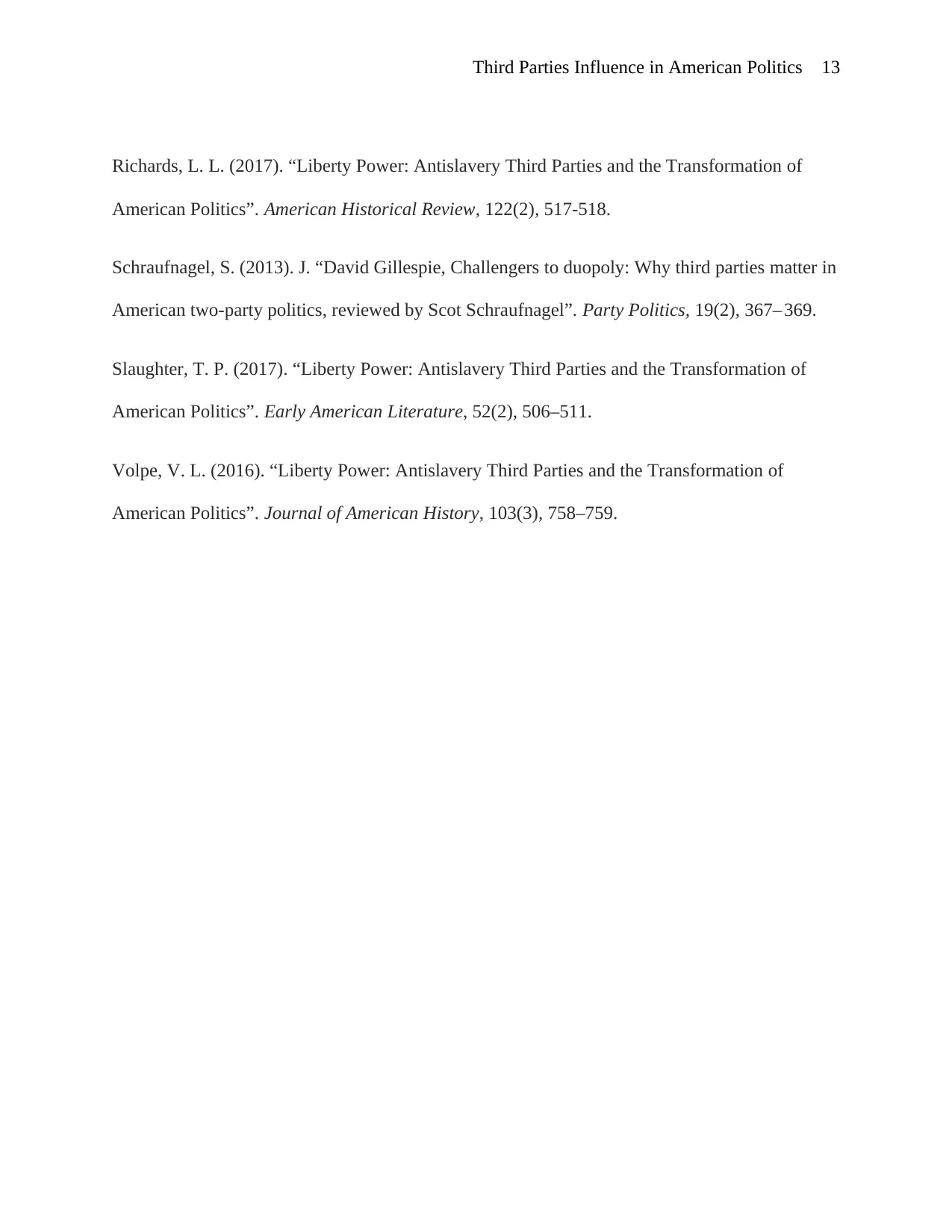
Third Parties Influence in American Politics 13
Richards, L. L. (2017). “Liberty Power: Antislavery Third Parties and the Transformation of
American Politics”. American Historical Review, 122(2), 517-518.
Schraufnagel, S. (2013). J. “David Gillespie, Challengers to duopoly: Why third parties matter in
American two-party politics, reviewed by Scot Schraufnagel”. Party Politics, 19(2), 367– 369.
Slaughter, T. P. (2017). “Liberty Power: Antislavery Third Parties and the Transformation of
American Politics”. Early American Literature, 52(2), 506–511.
Volpe, V. L. (2016). “Liberty Power: Antislavery Third Parties and the Transformation of
American Politics”. Journal of American History, 103(3), 758–759.
Richards, L. L. (2017). “Liberty Power: Antislavery Third Parties and the Transformation of
American Politics”. American Historical Review, 122(2), 517-518.
Schraufnagel, S. (2013). J. “David Gillespie, Challengers to duopoly: Why third parties matter in
American two-party politics, reviewed by Scot Schraufnagel”. Party Politics, 19(2), 367– 369.
Slaughter, T. P. (2017). “Liberty Power: Antislavery Third Parties and the Transformation of
American Politics”. Early American Literature, 52(2), 506–511.
Volpe, V. L. (2016). “Liberty Power: Antislavery Third Parties and the Transformation of
American Politics”. Journal of American History, 103(3), 758–759.
1 out of 13
Related Documents
Your All-in-One AI-Powered Toolkit for Academic Success.
+13062052269
info@desklib.com
Available 24*7 on WhatsApp / Email
![[object Object]](/_next/static/media/star-bottom.7253800d.svg)
Unlock your academic potential
© 2024 | Zucol Services PVT LTD | All rights reserved.





